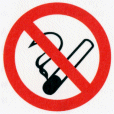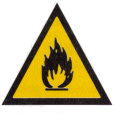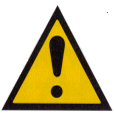BS 5499 Safety Signs, Including Fire Safety Signs
BS 5499 covers all safety warning sign, including fire safety signs and is compatable with the Health and Safety (Safety Signs and Signals) Regulations 1996. It is also compatable with the ISO standards relevant to fire signs but in regards to EC Safety Signs Directive 92/58/EEC – fire exit signs there is some confusion.
A sample of BS 5499 fire warning signs
 |
 |
Prohibition signs These signs prohibit actions detrimental to safety |
Black graphical symbol on a white circle within a circular red band and behind a red crossbar. |
 |
 |
Mandatory sign Signs that require actions or activities that will contribute towards safety |
White graphical symbol on a blue circle. Because the “Fire Door keep shut” sign doesn’t have a pictogram it is not in accordance with EC directive |
 |
 |
Warning signs These signs give warning of potential risks |
Black graphical symbol on a yellow triangle that has a strong black border. |
 |
 |
Safe Condition Signs These signs indicate exit routes in the event of a fire or emergency |
These signs indicate exit routes in the event of a fire or emergency |
 |
 |
Fire Equipment Signs These signs are used to indicate the location of fire equipment |
White graphical symbol on a red square. |
 |
 |
Supplementary Information Signs | Determined by the appropriate sign. |
BS 5499 Part 4
BS 5499 part 4 is devoted to escape route signing and while good sign design is important, the correct application and positioning of those signs is of equal significance in ensuring an effective signing system is in place. The size and positioning of signs within a building should form a major part of the considerations.
Points to consider are
- Sign type, sign size and viewing distance
- Construction durability and suitability
- Servicing and maintenance
- Illustrations (use of safety signs)
- Use of arrows to indicate direction of travel
The standard deals with the issues associated with designing a coordinated system of signage throughout any given building. The code outlines items that need to be addressed:
- Results of any risk assessment
- Requirements (if any) of enforcing authorities
- Operational needs of the building’s managers
- Convenience of the users of the building, both workers and Public
The code stresses that it is only through the consideration of these factors that an effective design system for escape route signing can be achieved. It provides clear guidance on how to do this.
Examples of BS 5499 Escape route signing
 |
 |
 |
| Supplementary directional arrow. | The internationally recognised graphical symbol for emergency exits | Supplementary text |
Consideration
Exhaustive testing of both comprehension and judgment of graphical symbols conforming to BS5499 and ISO 7010, ISO16069 achieved the highest comprehension credentials. However, as it only achieved some 80% performance, the British Standard requires supplementary text to aid comprehension. This too was tested and finally achieved 100% comprehension under ISO 9186. (Comprehension Testing Standard). Both the International and the British Standard Technical committee agreed that Escape Route Location and directional identification should not be left to graphic symbols alone. Consequently escape route signs should consist of three elements, the internationally-recognised graphical symbol for emergency exits, supplementary text (Exit or Fire exit) and a directional arrow.
Categories:Fire Safety Guides
March 28, 2011[Last updated: February 9, 2022]
Comments are closed here.